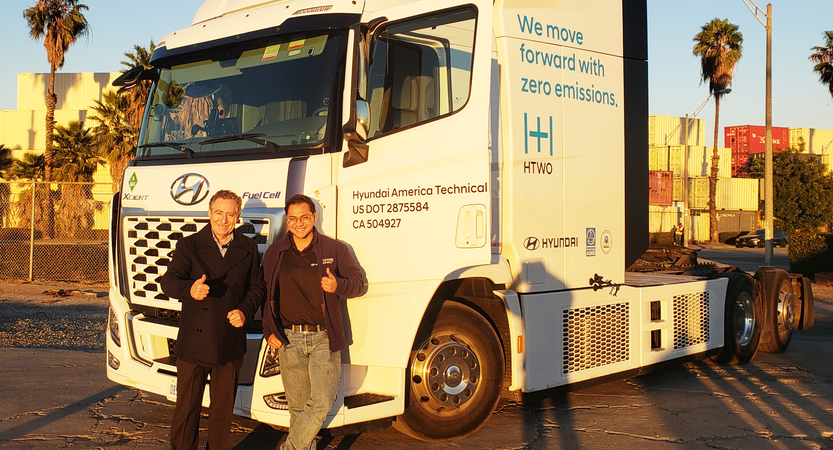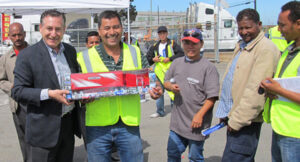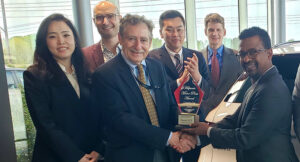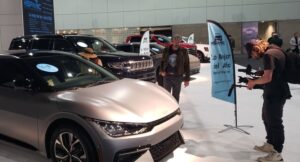Part of our outreach programs is to learn firsthand about the new available technologies. Thanks to the help from the Harbor Trucking Association and the Hyundai Motor Group, I could see and drive the XCIENT Fuel Cell electric Heavy Duty truck at the port of Long Beach.
Hyundai secured a $3.5 million Targeted Airshed Grant (TAG) from the U.S. EPA agency to deploy five of these trucks at the California ports. This project is guided by the SCAQMD, which applied for this funding. The program details include reducing emissions, generating measurable ozone reductions, and supporting the National Ambient Air Quality Standards. The TAG endorses the replacement of diesel-powered trucks with fuel-cell electric trucks.

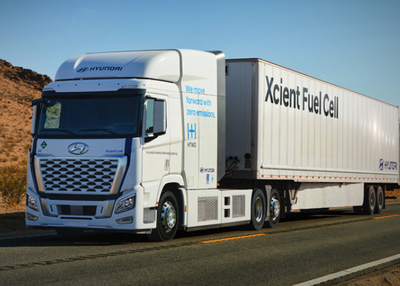
But do these trucks work? I spent time with Steve Ramirez, a Test Engineer for Hyundai, who patiently gave me an overall technical overview of the technology built into this class 8 truck. After our discussion and reviewing the data, I wanted to experience the drive to see if there was a difference. Not just on the reduction of pollutants but for the driver behind the wheel of this vehicle.
The driving experience is difficult to explain for the non-trucker person. The electric motor does not generate the vibrations present in a combustion engine. It does not require a cooling system with a pump that circulates coolant through the engine. The lack of all these mechanical components also removes the sound they create from the equation. Once you start rolling, the truck is very quiet and smooth. This comfort has yet to be part of the driver’s daily routine for port drivers.
This Hyundai has a much heavier tare than comparable Diesel trucks due to the weight of the battery packs. But the instant power provided by the electric motor makes the truck to be agile and quick to respond to the accelerator pedal.
Having been able to drive it, I learned that we currently have a viable truck to service the needs of the ports. Some technical revisions need to be worked out. These have to do with the original design created for the trucks to work in Europe. Their safety laws and regulations address some items differently, so these changes are being addressed. But overall, this Hyundai truck is almost ready.
What needs to be ready is the infrastructure required for this and other Fuel Cell options to make it a viable solution today. First Element Fuel (FEF) promises to deliver refueling stations within the next five years. Being the largest Hydrogen-refueling station operator in the country means they have the know-how to make this happen soon.
I am thankful to HTA and Hyundai for having allowed me to drive and confirm that this has tremendous potential as a replacement for Diesel trucks at the state’s ports. With this experience under my belt, I can continue educating California truckers about the upcoming truck technologies. For more information about the XCIENT Hyundai Truck
go to :https://www.hyundaimotorgroup.com/news/CONT0000000000054165
El presidente de HMP conduce el camión eléctrico de pila de combustible Hyundai XCIENT clase 8.
Parte de nuestros programas de divulgación es conocer de primera mano las nuevas tecnologías disponibles. Gracias a la ayuda de Harbor Trucking Association y Hyundai Motor Group, pude ver y conducir el camión eléctrico de servicio pesado XCIENT Fuel Cell en el puerto de Long Beach.
Hyundai obtuvo una subvención Targeted Airshed Grant (TAG) de $3.5 millones de la agencia EPA de EE. UU. para desplegar cinco de estos camiones en los puertos de California. Este proyecto está guiado por el SCAQMD, que solicitó este financiamiento. Los detalles del programa incluyen la reducción de emisiones, la generación de reducciones medibles de ozono y el apoyo a los Estándares Nacionales de Calidad del Aire Ambiental. El CTA avala la sustitución de camiones diésel por camiones eléctricos de pila de combustible.


¿Pero estos camiones funcionan? Pasé un tiempo con Steve Ramírez, un ingeniero de pruebas de Hyundai, quien pacientemente me brindó una descripción general técnica de la tecnología integrada en esta camioneta de clase 8. Después de nuestra discusión y de revisar los datos, quería experimentar el manejo para ver si había alguna diferencia. No solo en la reducción de contaminantes sino para el conductor al volante de este vehículo.
La experiencia de conducción es difícil de explicar para la persona que no es camionero. El motor eléctrico no genera las vibraciones presentes en un motor de combustión. No requiere un sistema de enfriamiento con una bomba que haga circular refrigerante a través del motor. La falta de todos estos componentes mecánicos también elimina el sonido que crean de la ecuación. Una vez que comienza a rodar, el camión es muy silencioso y suave. Esta comodidad aún no forma parte de la rutina diaria del conductor para los conductores portuarios.
Este Hyundai tiene una tara mucho más pesada que las camionetas diésel comparables debido al peso de los paquetes de baterías. Pero la potencia instantánea proporcionada por el motor eléctrico hace que el camión sea ágil y rápido para responder al pedal del acelerador.
Habiendo podido conducirlo, supe que actualmente tenemos un camión viable para atender las necesidades de los puertos. Algunas revisiones técnicas necesitan ser elaboradas. Estos tienen que ver con el diseño original creado para que los camiones funcionen en Europa. Sus leyes y reglamentos de seguridad abordan algunos elementos de manera diferente, por lo que se están abordando estos cambios. Pero en general, esta camioneta Hyundai está casi lista.
Lo que debe estar listo es la infraestructura requerida para esta y otras opciones de celdas de combustible para que sea una solución viable hoy. First Element Fuel (FEF) promete entregar estaciones de servicio en los próximos cinco años. Ser el operador de estaciones de servicio de hidrógeno más grande del país significa que tienen el conocimiento para hacer que esto suceda pronto.
Estoy agradecido con HTA y Hyundai por haberme permitido conducir y confirmar que esto tiene un tremendo potencial como reemplazo de los camiones diésel en los puertos del estado. Con esta experiencia en mi haber, puedo continuar educando a los camioneros de California sobre las próximas tecnologías de camiones. Para obtener más información sobre el camión XCIENT Hyundai
vaya a: https://www.hyundaimotorgroup.com/news/CONT0000000000054165

